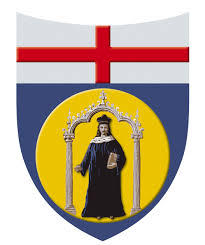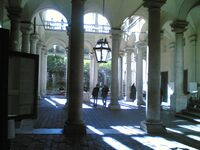University of Genoa
(University) | |
|---|---|
 | |
| Formation | 1481 |
| Headquarters | Genoa, Italy |
| Type | State-supported |
| One of the largest universities in Italy. | |
The University of Genoa, known also with the acronym UniGe (Università di Genova), is one of the largest universities in Italy. It is located in the city of Genoa and regional Metropolitan City of Genoa, on the Italian Riviera in the Liguria region of northwestern Italy. The original university was founded in 1481.
According to Microsoft Academic Search 2016 rankings, the University of Genoa has high-ranking positions among the European universities in multiple computer science fields:
- in machine learning and pattern recognition the University of Genoa is the best scientific institution in Italy and is ranked 36th in Europe;[1]
- in computer vision the University of Genoa is the best scientific institution in Italy and is ranked 34th in Europe;[2]
- in computer graphics the University of Genoa is ranked 2nd institution in Italy and 35th in Europe.[3]
The University of Genoa has a strong collaboration with the Italian Institute of Technology (IIT), since its foundation in 2005.
The University of Genoa is currently setting up a big project for a new Faculty of Engineering within the Erzelli Great Campus science technology park, in the Western side of Genoa. The contracts were signed in October 2018, the final project should be released in 2019, the construction works should start in 2020, and the new faculty should open in 2023.[4]
Campus
The University of Genoa is organized in several independent campuses located in different city areas. Notable buildings are the main University premises (Via Balbi, 5) designed by the architect Bartolomeo Bianco and built in 1640, the new complex in Valletta Puggia, built in the 1980s and 1990s and hosting the Departments of Chemistry, Computer Science, Mathematics, and Physics, and the new seat of Facoltà di Economia, realized in 1996 by refurbishing old seaport docks. The University's botanical garden, the Orto Botanico dell'Università di Genova, occupies one hectare in the city center, just above the University's main building.
University of Genoa also has a number of regional campuses in Savona, Imperia, Santa Margherita Ligure, Ventimiglia and La Spezia.
History
Already in the 13th century in Genoa there were Colleges which conferred degrees in law, theology, medicine and arts.
The College of Theology was established officially in 1471 with a Papal Bull of Sixtus IV (Francesco della Rovere). Some years after dates the promulgation of a Statute of the College of Medicine by the Council of the Elders in 1481.
In 1569, by a decree of the Senate of Republic of Genoa, the Colleges were incorporated into the schools run by the Jesuits. The Jesuits settled near the old Church of San Girolamo Del Rosso, and enlarged their premises by buying some land on which to house their College and schools. The building, which is now the main University premises, was designed by the architect Bartolomeo Bianco, and began to be used in 1640.
After the suppression of the Society of Jesus in 1773, a special Committee reorganized the various courses of study, dividing them in higher education (Canon Law, Philosophy, Civil Law, Theology, Logic and Metaphysics, Physics) and primary education (courses in Rhetoric, Reading and Writing).
After the establishment of the French Empire, which absorbed the Republic of Genoa, higher education was subdivided into different special Schools: Law, Medicine, Physical and Mathematical Sciences, Commerce, Language and Literature, Chemistry. The University of Genoa was affiliated to the Imperial University of Paris. It was reinstated as a separate university in 1812.[1]
After the fall of Napoleon, the provisional Government of the Republic appointed a new Committee in charge of higher education, and at the Congress of Vienna in 1815 it was decided that the University of Genoa be entrusted to the Kingdom of Sardinia, enjoying the same privileges as those granted to the University of Turin. The university was closed owing to political disturbances between 1821 and 1823 and again between 1830 and 1835.
In 1870, two first technical institutes of higher education were established: the Royal Naval School and the Royal School of Economic Studies, that in 1936 were absorbed by the Royal University of Genoa, becoming the Faculties of Engineering and Economics respectively.
In the late 20th century, the university expanded rapidly, with new regional campuses. In 1996 some departments were established in Savona within a remodeled Army Barrack area. That campus hosts the Department of Engineering and also courses in Business. New laboratories have been made in Simulation, Logistics & Industrial Engineering, among others.
In January 2001, an "Institutional Review of University of Genoa" was given by CRE Institutional Evaluation Programme. This evaluation, surveys taken and reports made, explain The University's current promotion of invitations to outside professorships and student body.
Alumni on Wikispooks
| Person | Born | Died | Nationality | Summary | Description |
|---|---|---|---|---|---|
| Roberto Burioni | 1962 | Italy | Big pharma/Lobbyist Virologist | Italian virologist and academic who was given prominence in Italy for his strong stance against the antivaccination movement. The loudest proponent of the lockdowns and other policies from the start of Covid in 2020. | |
| Giulietto Chiesa | 4 September 1940 | 26 April 2020 | Italy | Journalist Activist Politician | Italian journalist and dissident. Increasingly in the sights of the intelligence services because of his opposition to the New Cold War. |
| Paolo Fresco | July 1933 | Italy | Lawyer Businessperson | Italian Bilderberg businessman. Ex Fiat Chairman | |
| Alberto Pirelli | 1882 | 1971 | Italy | Deep state actor Businessperson | Italian businessman who attended the first Bilderberg and 7 others up to 1963. |
| Paolo Rossi | 15 September 1900 | 24 May 1985 | Italy | Politician | President of Antimafia Commission, attended the first Bilderberg and the 1956 Bilderberg |
References
- ↑ https://archive.today/20160311035732/http://academic.research.microsoft.com/RankList?entitytype=7&topdomainid=2&subdomainid=6&continentid=4
- ↑ https://academic.microsoft.com/%7Ctitle=Microsoft Academic|website=academic.microsoft.com
- ↑ https://academic.microsoft.com/%7Ctitle=Microsoft Academic|website=academic.microsoft.com
- ↑ http://www.great-campus.it/universita-firma-erzelli/ L’Università di Genova firma il contratto per l’acquisto dei terreni di Erzelli
